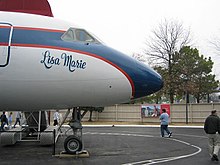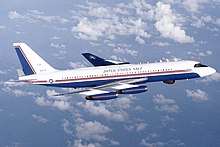Convair CV-880
| Convair CV-880 Golden Arrow | |
|---|---|

|
|
| Type: | Four - engined narrow-body aircraft |
| Design country: | |
| Manufacturer: | |
| First flight: |
January 27, 1959 |
| Production time: |
1959 to 1963 |
| Number of pieces: |
65 |
The Convair CV-880 Golden Arrow , also known as the Convair 880 , is a four-engine airliner produced by the Consolidated Vultee Aircraft Corporation , called Convair. The original nickname was Skylark , but was changed to Golden Arrow for reasons of advertising in allusion to the high cruising speed of almost 1,000 km / h ( Mach 0.87) .
history
The aircraft, which first flew in 1959, is one of the fastest and loudest passenger jets. The CV-880 has a cruising speed of almost 1,000 km / h ( Mach 0.87) - today's airliners like the Boeing 757 only fly at 870 km / h. The Convair 880 remains one of the fastest subsonic passenger aircraft ever built. However, the successor Convair CV-990 was even faster . The jet engines of the type General Electric CJ-805-3 of the CV-880 corresponded to those of the Phantom II -Jägers, but without afterburner .
Coming out as an aerodynamically excellent aircraft with great expectations, the CV-880 could only stand up to its competitors Boeing 707 and DC-8 due to its higher fuel consumption and the smaller number of passenger seats (five per row instead of six; a total of 88 to 100 seats) 65 machines were built. Even an enlarged further development of the CV-880, the Convair CV-990 introduced in 1961 , did not help to improve sales figures. The total production of the Convair 880/990 family amounted to just 102 units until production was discontinued in 1965.
As early as the early 1970s, many airlines put the CV-880 and 990 out of service again, whereupon some of them were removed to cargo planes and tourist planes with, in the case of the CV 990, up to 149 seats or scrapped. The last CV-880 in the years 1975 / 1976 -passenger flight operations withdrawn from the commercial, Last operator was the former national airline of Nicaragua , Lanica . With the Federal Aviation Administration (FAA) and the US Navy , individual copies were still in use until the beginning of the 1990s.
Losses from design and manufacture of the types CV-880 and 990 figured on a sum of 425 million US dollars ($). In relation to the year 1963, the end of the Convair 990 production, this corresponds to a current value of $ 3.5 billion , taking into account inflation . To date, this represents the biggest failure an aircraft manufacturer has survived without going bankrupt . However, Convair subsequently withdrew from the production of passenger aircraft and concentrated on its role as a supplier to the aerospace industry.
Some examples of the CV-880 have survived to this day, including Elvis Presley's former private plane, which can be viewed at Presley's former residence Graceland .
Some decommissioned CV-880s, most of which were previously in service with Trans World Airlines , have been parked in the aircraft graveyard at Mojave Airport and Atlantic City International Airport since the late 1970s . However, since some of these machines have been exposed to the weather for decades without protection, most of them are in a relatively poor condition. The last Convair 880 (a former TWA machine) was flown by the Federal Aviation Administration for test purposes in the early 1990s , but then also parked at Atlantic City Airport. So today there is no longer a CV 880 in airworthy condition, although there have been several initiatives over the years to get one of the machines from Atlantic City back on the road.
Operator (historical)
Operator of brand new machines
- Alaska Airlines
- Cathay Pacific Airways
- Civil Air Transport (Taiwan)
- Delta Air Lines
- Japan Air Lines
- Japan Domestic Airways (leased from Japan Air Lines)
- Northeast Airlines (leased from Hughes Tool Co. )
- Swissair
- Trans World Airlines
- VIASA
Operators of used machines

- Airtrust Singapore
- Air Viking
- Central American Airways / Profit Express
- Civil Air Transport
- Four Wings Inc.
- Freelandia Travel Club
- Groth Air
- Inair Panama
- Indy Air
- Jonian Airways
- LatinCarga
- Lineas Aereas de Nicaragua (LANICA) (last commercial operator of the type)
- Monarch Airlines (USA)
- SECRA
- One of Elvis Presley's private planes was a CV-880 previously operated by Delta Air Lines ; the machine can be viewed today at Presley's former residence Graceland . Several other CV-880s were also used as private and VIP jets after they retired from regular service.
Military users
-
 United States - The US Navy bought a CV-880 which was converted into a tanker and flying test stand. The aircraft, unofficially designated as the UC-880, was assigned to Naval Air Station Patuxent River and used in Tomahawk cruise missile tests and to develop aircraft refueling procedures . In 1995 the UC-880 was destroyed in a cargo hold explosion test.
United States - The US Navy bought a CV-880 which was converted into a tanker and flying test stand. The aircraft, unofficially designated as the UC-880, was assigned to Naval Air Station Patuxent River and used in Tomahawk cruise missile tests and to develop aircraft refueling procedures . In 1995 the UC-880 was destroyed in a cargo hold explosion test.
Incidents
From the first flight in 1959 to the end of operations in the early 1990s, the Convair CV-880 suffered 17 total aircraft losses. In 8 of them, 171 people were killed. Examples:
- On September 13, 1965, a Convair CV-880 of the US American Trans World Airlines (TWA) ( aircraft registration number N820TW ) crashed at Kansas City-Downtown Airport ( Missouri , USA) during a training flight. The simulated failure of engine no. 4 (far right) resulted in a loss of control and stall . The machine was destroyed on impact, but all four crew members, the only occupants, survived.
- On November 20, 1967, a Trans World Airlines (TWA) (N821TW) CV-880 flew off-road during a night approach in light snowfall just 3 km before reaching the runway at Cincinnati Airport . Of the 82 occupants, 70 were killed (see also Trans-World Airlines Flight 128 ) .
- The worst accident involving a CV-880 occurred on June 15, 1972 when a Cathay Pacific machine from Hong Kong (VR-HFZ) was destroyed by a bomb while it was cruising on its way from Bangkok to Hong Kong. The plane crashed in a jungle area in Vietnam, all 81 people on board were killed ( see also Cathay Pacific flight 700Z ).
Technical data (Model 22-M)
- Length: 39.42 m
- Height: 11.00 m
- Span: 36.58 m
- Wing area: 185.8 m²
- Wing aspect ratio: 7.2
- Maximum take-off weight: 87,730 kg
- Empty weight: 42,730 kg
- Payload: 10,900 kg
- Cruising speed: 990 km / h
- Maximum altitude: 12,500 m
- Passenger capacity: 110
- Range: 4,430 km
- Engines: four General Electric CJ805-3 Turbojet with each thrust: 51.95 kN
See also
Web links
- Civil Aviation: Convair Coronado
- "The might have beens - Convair 880 and 990" by Tim Haskins (airliners.net), engl.
Individual evidence
- ↑ Accident Statistics Convair CV-880 , Aviation Safety Network (English), accessed on January 16, 2018.
- ^ Accident report Convair CV-880 N820TW , Aviation Safety Network (English), accessed on June 23, 2020.
- ^ Accident report Convair CV-880 N821TW , Aviation Safety Network (English), accessed on January 20, 2016.
- ^ Accident report Convair CV-880 VR-HFZ , Aviation Safety Network (English), accessed on January 20, 2016.

